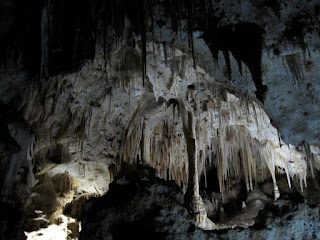
The next morning we headed into the south entrance of Zion and immediately found a campsite for the evening. We walked to the visitor center and boarded the shuttle to see the scenic points within the canyon. Our first stop was at the Court of the Patriarchs - three gigantic formations named Abraham, Isaac and Jacob.

We boarded the shuttle and stopped to hike the Emerald Pool Trails. The paths took us to three separate oases where water collects from the porous rocks. The sun was hot so we took a break in the shade at each one. We had to eat our snacks quickly due to an overzealous squirrel that had obviously been used to getting food from humans.

Heading back towards the valley floor, we stopped at the Zion Lodge for lunch at the restaurant. Two huge sandwiches later, we were ready for a couple hours of couch time.
We pressed on and went to Weeping Rock. The huge rock overhead featured hanging gardens and water dripping down onto the path. I stood under one of the “drips” to wet my hair and cool down in the hot and humid weather.

At the end of the shuttle line, we intended to hike into the Narrows but lightning and thunder changed our plans. We got on the shuttle and went to the Human History Museum for some inside time. During the ranger program that we attended, a rainstorm in the distance created a waterfall that lasted roughly ten minutes and then disappeared!

After coming back to our campsite, we decided that we needed to drive some of the east entrance road to see some of the famous formations within Zion NP. We drove through the mile-long tunnel and stopped at the Checkerboard Mesa for pictures. The landscape to the east is much different terrain than the valley itself.

We stayed the night and wanted to do some hiking, but the weather forecast contained too much lightning for us to feel comfortable climbing on bare rocks. After breakfast, we bid farewell to Zion and headed towards Las Vegas.
Hoover Dam was our first stop of the day. It was a beautiful piece of engineering surrounded by the most rude people that we had encountered yet on the trip. We ate lunch at the cafe and snapped some pictures of the dam but didn’t take a tour. We drove over the top of the dam since they are closing it to traffic later this year.
Skirting Las Vegas, we drove to Death Valley National Park in the afternoon. Our first stop was at an overlook of the area where it was 110 and breezy. It felt like being in a dryer. Our clothes certainly weren't dry after being out of the car for a few minutes though...

We stopped at the visitor center and then headed south to Badwater Basin, the lowest point in the United States. We were amazed to see water on the ground when the thermometer in the car was now reading 120!

Driving north through the park, we drove the Artist’s Loop and stopped to view the sand dunes. As expected, it was too hot to spend any significant amount of time out of the car.

We headed out of the park and stopped at a campground on the way to Sequoia and King’s Canyon National Parks. We’re hoping that forest fires don’t impede our plans!












































